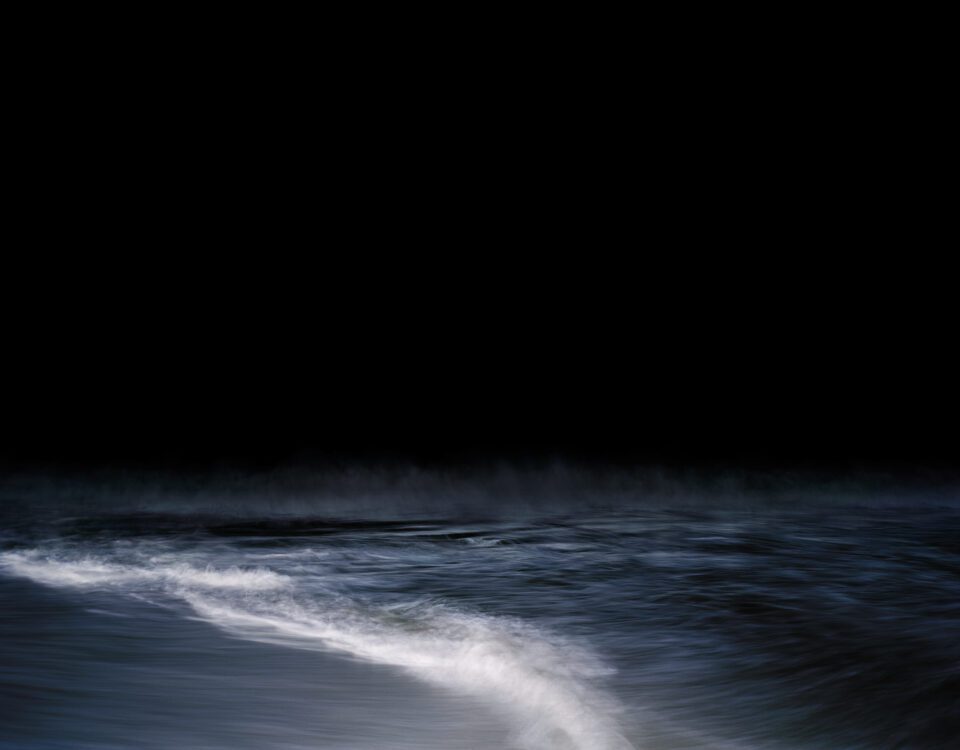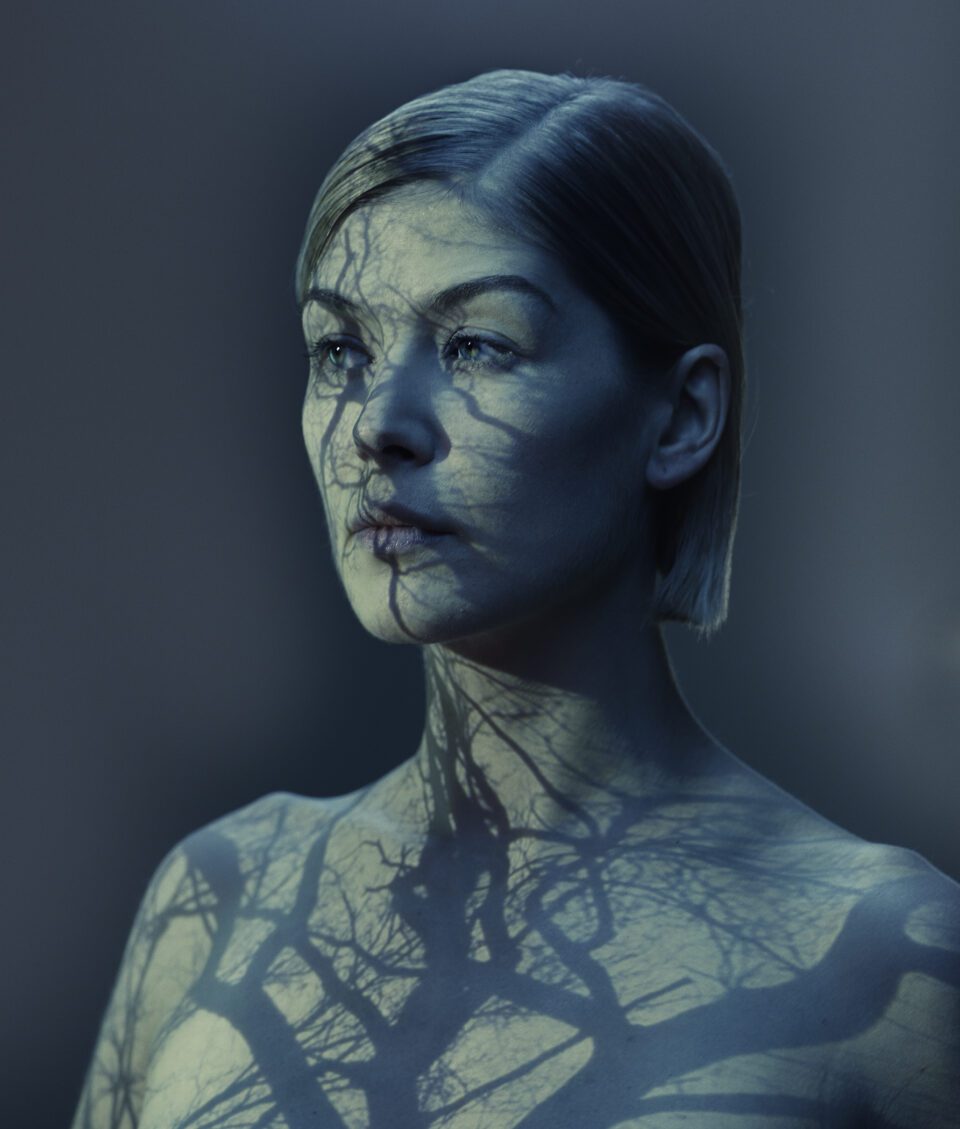Israeli-born, London-based photographer Nadav Kander (b. 1961) has produced some of the most mesmerising portrait and landscape photography of our times. Amongst the best known is Yangtze, The Long River, for which he won the Prix Pictet – a global award in photography and sustainability. The series was created between 2006 and 2008: a time when unprecedented industrial and urban growth was erasing and remaking the landscapes of China. Bathers perch on rocks in clouds of smog; vast, tenuous grids of scaffolding prop up half-built highways; farmers tend their crops in the shadow of the encroaching metropolis. In 2017, Kander’s Dark Line – The Thames Estuary brought a similar energy to London’s river.
Kander is also renowned for his portraits, which have featured well-known figures from the worlds of politics, culture and music, as well as anonymous sitters. These works combine a timeless, statuesque quality with a psychological intensity: the impression of a depth of feeling and thought that lies just beyond the viewer’s reach. The 2009 series Obama’s People, for the New Yorker Magazine, featured the president and his 53-strong circle of advisers, the largest set of images by a single photographer ever featured in the magazine. In 2013, Kander exhibited Bodies, showing nude figures daubed in white powder. These studies had something of the quality of plaster casts or masks, hinting at the uncanny.
New exhibition The Thread, opening at New York’s Howard Greenberg Gallery, brings together landscapes and portraits from the 1990s to the 2020s, and from all around the world, from Chernobyl to the Arctic Circle. Aesthetica spoke to Kander about the new show and the sweep of his work to date.

A: Can you give us a sense of the range of work on offer in The Thread; what story do you hope the exhibition tells?
NK: I am increasingly interested in the magnified effect my work can have when it is curated ignoring the constraints of time or geography. The idea of “the thread”, as a thought or a visualisation, is one I like very much. I see all the successful pictures I’ve made as one ongoing collection or body of work. I find that I approach the same themes and play the same chords again and again, finding different directions and subject matter to photograph that play this out.
The works on show, whether from the 1990s or 2021, fit together as if they were a community of different personalities, but with a common voice. These include landscapes from Russia, China, England, Finland and a seascape from Brazil. There are also portraits of people I know, and some that were strangers when we met. As for stories, I am not trying to tell stories. I simply suggest that there is more beneath what it is you think you are looking at. The rest is left to you—the story is yours.
A: You have spoken of wanting to “drill down to the essence of things” through your portraiture. Can you talk a little more about how that?
NK: My work has human beings at centre stage. Either by virtue of what is shown and suggested or because of how a viewer may feel when confronted by the work. At a certain level, I don’t see separation in my work: a landscape showing the palm print of humanity upon the natural world, the way we exist within our environment, is as much a portrait of a human being as a close-up photograph of a person. The close-up portraiture just feels like it brings a greater level of scrutiny, a sustained focus on vulnerability, solitude, quiet, love, envy, greed and other emotions that we have all felt and that we recognise in others.

A: Your work has sometimes focused on rivers, such as the Yangtze and the Thames. What fascinates you about this subject?
NK: I am certainly very drawn to water. The calmness I feel when near open water is important to me. Rivers, in particular rivers that flow near dense human populations, invoke in me a sense of enduring generations. With this in mind I make the work, often with human beings shown as small or not present at all.
A: You are a renowned portrait photographer. How do you unlock the character of a sitter, and what makes a good sitting to you?
NK: Any successful picture of mine has an atmosphere that cannot be seen but can be felt. The difference between the wider views showing human beings outdoors and the indoor, close-up views of our faces is that I must use lighting for the latter. Lighting is the beginning of my building the atmosphere. The sitter occupies the scene, bringing their own atmosphere, and a kind of dance occurs as we become more used to each other. I am not after “relaxed”. Relaxed is overrated. I look for the flow when ego and one’s own histories are put aside (for both of us) and a picture can be made such that, hopefully, a viewer is jolted and moved enough to look into their own stories. That is a successful picture to me.

A: Howard Greenberg Gallery describes your work as “evok[ing] the interconnectedness of humanity.” What do you see as the power of photography in an age of political polarisation and renewed fears about global conflict?
NK: Howard Greenberg Gallery are showing my pictures so that the single works are brought together into a greater whole. This will add layers for a viewer far beyond those of the singular works. This mirrors an interconnected society: individual humans connected in the realisation that all the conditions that make us human connect us: we have them all in common. I wish we would not see ourselves as separate from the natural world around us. I think with the rise in fascism, the clampdown of free speech and, possibly most importantly, the climate crisis, any work I make cannot ignore these subjects.
The Thread runs 22 April – 17 June. Find out more here.
Words: Greg Thomas
All images: Copyright Nadav Kander, Courtesy Howard Greenberg Gallery, New York
Nanjing X, Jiangsu Province, 2007, from the series Yangtze – The Long River, Chromogenic print, printed 2022. Image size: 38 x 48 3/8 inches. Paper size: 48 1/4 x 58 3/4 inches
Atlantic Ocean III (Copacabana Beach), Brazil, 2003, from the series Colour Fields Chromogenic print, printed 2022, 38 x 78 3/8 inches
Rosamund Pike II, Los Angeles, USA, 2014. Pigment print, printed 2022 Image size: 26 x 22 inches. Paper size: 26 x 22 inches
Water III, part 1, 2 & 3 (Shoeburyness towards The Isle of Grain), England, 2015, from the series Dark Line – The Thames Estuary Three archival pigment prints, 44 x 19 5/8 inches each.





